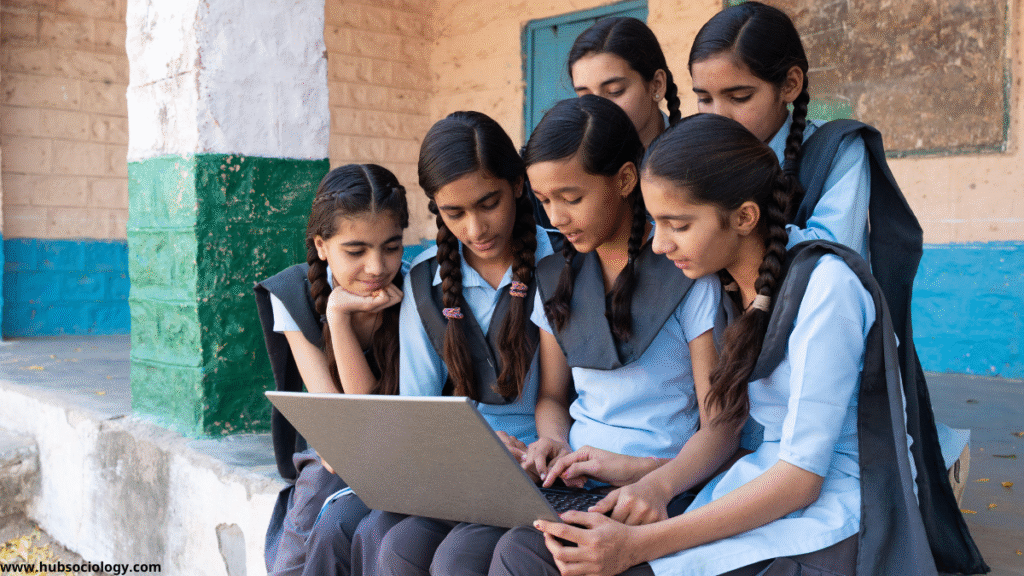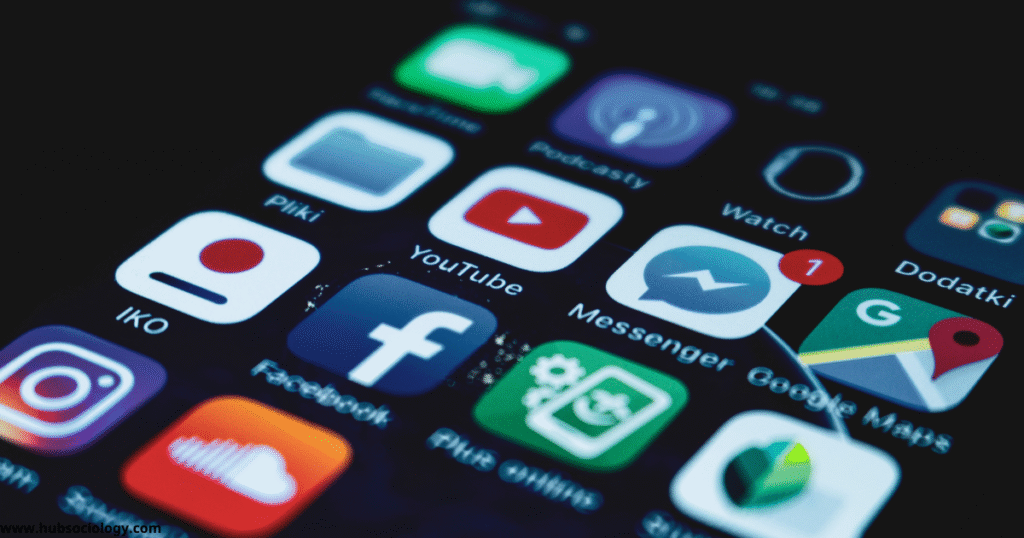Introduction on Impact of Social Media
In the past decade, social media has transformed the way people communicate, interact, and perceive the world. In India, with one of the largest youth populations globally, social media platforms like Facebook, Instagram, Twitter (now X), WhatsApp, and TikTok (before its ban) have become integral to daily life. While these platforms offer numerous benefits, such as connectivity, education, and entertainment, they also pose significant sociological challenges, including mental health issues, identity crises, and cultural shifts.
This article examines the impact of social media on Indian youth from a sociological perspective, analyzing both its positive and negative consequences on behavior, relationships, and societal norms.

Table of Contents
The Rise of Social Media in India
India has over 700 million internet users, with a majority being young adults and teenagers. The proliferation of affordable smartphones and cheap data plans has accelerated social media penetration. According to a 2023 report by the Internet and Mobile Association of India (IAMAI), around 70% of urban youth and 45% of rural youth actively use social media.
Platforms like Instagram and YouTube have become spaces for self-expression, activism, and even career opportunities. However, the rapid adoption of these platforms has also led to significant sociological changes, reshaping how young Indians form identities, engage in politics, and interact with society.
Positive Impacts of Social Media on Indian Youth
1. Enhanced Communication and Connectivity
Social media bridges geographical gaps, allowing young Indians to stay connected with friends and family, especially in a country where migration for education and employment is common. Platforms like WhatsApp and Facebook facilitate real-time communication, reducing feelings of isolation.
2. Access to Information and Education
YouTube, LinkedIn, and educational Facebook groups provide free learning resources, career guidance, and skill development opportunities. Many Indian youth use these platforms to prepare for competitive exams, learn new languages, or acquire technical skills.
3. Platform for Social Activism and Awareness
Movements like #MeToo, #FarmersProtest, and #JusticeForSSR have gained momentum through social media, empowering youth to voice their opinions on social injustices. Young activists leverage Twitter and Instagram to mobilize support, challenge authorities, and demand accountability.
4. Career and Entrepreneurial Opportunities
Influencer culture, digital marketing, and content creation have opened new career paths. Many Indian youth are turning into YouTubers, bloggers, and Instagram influencers, monetizing their creativity. Startups and small businesses also use social media for branding and sales.
Negative Impacts of Social Media on Indian Youth
Despite its advantages, social media has several adverse effects on Indian youth, influencing their mental health, social behavior, and cultural values.
1. Mental Health Issues: Anxiety, Depression, and Low Self-Esteem
- Comparison Culture: Constant exposure to curated, idealized lives on Instagram leads to unrealistic expectations, fostering feelings of inadequacy.
- Cyberbullying: Online harassment, trolling, and body-shaming contribute to anxiety and depression among young users.
- Fear of Missing Out (FOMO): The pressure to stay constantly updated creates stress and reduces real-life social interactions.

2. Addiction and Reduced Productivity
Excessive use of social media leads to addiction, affecting academic performance and work efficiency. Many youths spend hours scrolling through reels and posts, leading to procrastination and decreased attention spans.
3. Erosion of Traditional Social Structures
- Decline in Face-to-Face Interactions: Virtual interactions are replacing physical meet-ups, weakening interpersonal skills.
- Changing Family Dynamics: Younger generations often prioritize online socialization over family bonding, leading to generational gaps.
4. Spread of Misinformation and Polarization
- Fake News: WhatsApp forwards and viral posts often spread unverified information, leading to panic and misinformation.
- Political Polarization: Social media algorithms reinforce echo chambers, deepening ideological divides among youth.
5. Influence on Cultural Values and Identity
- Westernization vs. Traditional Values: Exposure to global trends sometimes leads to conflicts between modern aspirations and traditional Indian values.
- Consumerism and Materialism: Ads and influencer promotions encourage excessive spending on fashion, gadgets, and luxury items, fostering materialistic attitudes.
Sociological Theories Explaining Social Media’s Impact
Several sociological theories help analyze the effects of social media on Indian youth:
1. Symbolic Interactionism
This theory suggests that individuals derive meaning from social interactions. Social media shapes self-identity through likes, comments, and shares, influencing how young people perceive themselves and others.
2. Functionalism
From a functionalist perspective, social media serves both manifest (intended) functions (e.g., communication) and latent (unintended) functions (e.g., addiction). It also causes dysfunctions, such as misinformation and cybercrime.
3. Conflict Theory
Social media reflects societal inequalities. Privileged youth with better access to technology benefit more, while marginalized groups face digital exclusion. Additionally, corporate control over platforms influences public opinion.
4. Dramaturgical Theory (Goffman)
Goffman’s theory compares social life to a theater where individuals perform roles. On social media, youths carefully curate their online personas, leading to a disconnect between their real and virtual identities.
Case Studies: Social Media’s Role in Shaping Indian Youth
1. The Rise of Influencer Culture
Indian youth increasingly aspire to become influencers, prioritizing online fame over conventional careers. This shift reflects changing aspirations and economic models.
2. Social Media and Political Participation
During elections, young voters engage in online debates, but misinformation campaigns manipulate opinions, as seen in the 2019 and 2024 general elections.
3. Mental Health Crisis Among Students
Cases of student suicides linked to academic pressure and social media bullying highlight the need for better digital well-being policies.
Government and Institutional Responses
Recognizing social media’s risks, the Indian government has introduced:
- IT Rules (2021): Holding platforms accountable for harmful content.
- Digital Literacy Programs: Educating youth on responsible usage.
- Ban on Harmful Apps: Like TikTok, due to data privacy and content concerns.
Conclusion on Impact of Social Media
Social media’s impact on Indian youth is profound and multifaceted. While it fosters connectivity, education, and activism, it also contributes to mental health crises, addiction, and cultural shifts. A balanced approach—promoting digital literacy, mental health awareness, and ethical usage—is essential to harness its benefits while mitigating harms.

As India progresses digitally, understanding the sociological implications of social media will be crucial in shaping a generation that is informed, resilient, and socially responsible.
Do you like this this Article ? You Can follow as on :-
Facebook – https://www.facebook.com/hubsociology
Whatsapp Channel – https://whatsapp.com/channel/0029Vb6D8vGKWEKpJpu5QP0O
Gmail – hubsociology@gmail.com
Topic Related Questions on Impact of Social Media
5-Mark Questions on Impact of Social Media (Short Answer Type)
- Define social media and briefly explain its role in modern Indian society.
- How has social media influenced political awareness among Indian youth?
- What are the positive effects of social media on education and career opportunities for Indian youth?
- Explain how cyberbullying affects the mental health of young social media users.
- What is FOMO (Fear of Missing Out), and how does it impact Indian youth?
- How does social media contribute to the spread of fake news in India?
- Briefly discuss the role of influencers in shaping youth culture in India.
- What are some ways in which social media has changed family interactions in India?
- How does social media addiction affect academic performance?
- What measures has the Indian government taken to regulate social media platforms?
10-Mark Questions on Impact of Social Media (Descriptive Answer Type)
- Discuss the impact of social media on the mental health of Indian youth, highlighting anxiety, depression, and self-esteem issues.
- Explain how social media has become a tool for social activism among Indian youth, with examples.
- Analyze the role of social media in shaping career opportunities for young Indians.
- How has social media contributed to both cultural globalization and cultural erosion in India?
- Discuss the influence of social media on interpersonal relationships among Indian youth.
- Examine the role of social media in political polarization among Indian youth.
- How does the “comparison culture” on platforms like Instagram affect young Indians?
- Evaluate the pros and cons of influencer culture in India.
- Discuss the impact of social media on traditional forms of entertainment (TV, newspapers) in India.
- How can digital literacy help mitigate the negative effects of social media on Indian youth?
15-Mark Questions on Impact of Social Media (Essay-Type/Long Answer)
- Critically analyze the impact of social media on Indian youth from a sociological perspective, covering both positive and negative aspects.
- “Social media is a double-edged sword for Indian youth.” Discuss this statement with relevant examples.
- Examine how social media has transformed communication, relationships, and cultural values among Indian youth.
- How has social media influenced the political participation of Indian youth? Discuss with recent examples.
- Discuss the role of social media in the rise of mental health issues among Indian students. Suggest measures to address this problem.
- Evaluate the impact of Westernization through social media on Indian traditions and youth behavior.
- How does social media contribute to consumerism and materialism among Indian youth? Discuss its long-term effects.
- “Social media is reshaping India’s job market and entrepreneurial trends.” Critically analyze this statement.
- Discuss the ethical concerns related to social media usage among Indian youth, including privacy, misinformation, and cybercrime.
- How can parents, educators, and policymakers ensure responsible social media usage among Indian youth?
